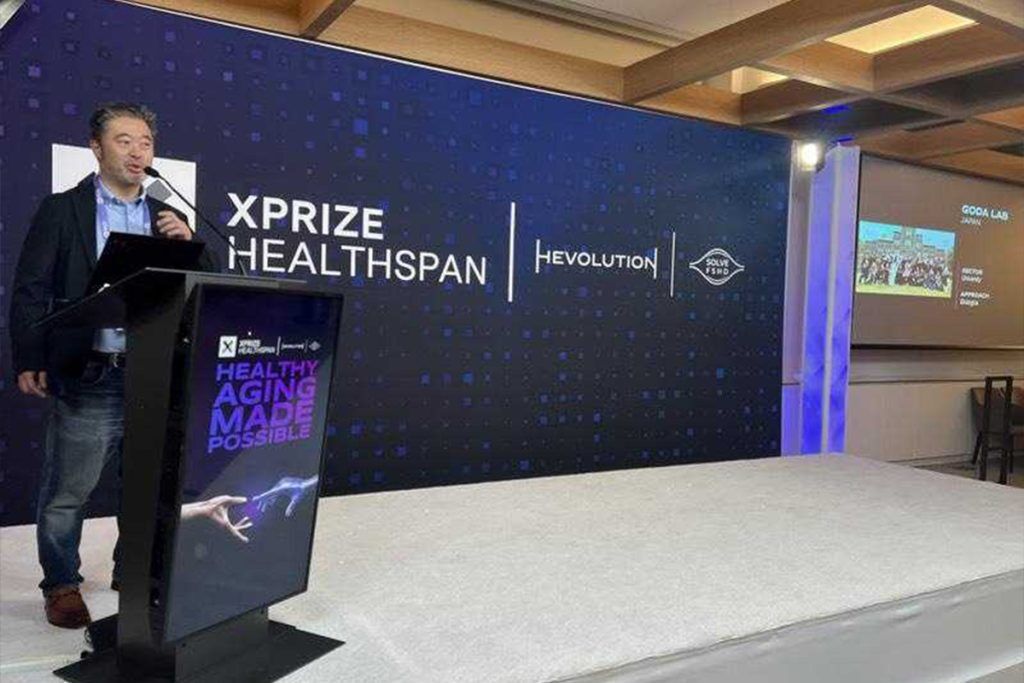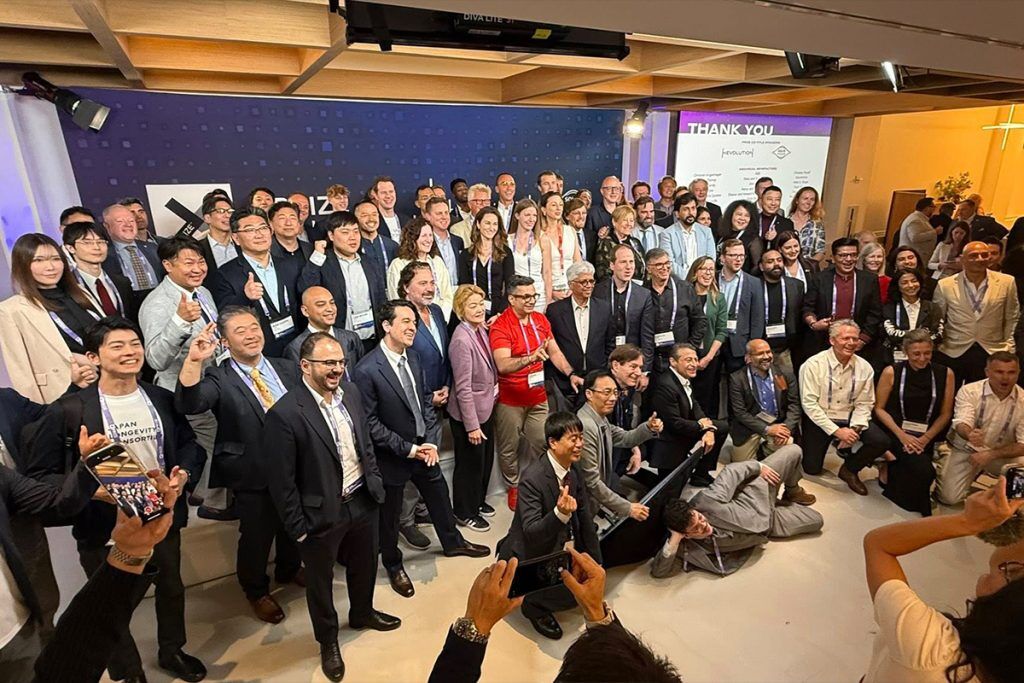Goda Lab’s SHT-sEV therapy combines physics and biology in Japan’s ambitious bid to reshape rejuvenation science.
Continuing our exploration of the XPRIZE Healthspan Top 40 in partnership with our friends at TimePie, we travel to Tokyo, where a team better known for optical physics than for biology is rethinking how rejuvenation signals move through the body. At Goda Lab, nanotechnology meets regenerative medicine in a project that may redefine how we approach the science of aging.
When the XPRIZE Healthspan competition announced its semi-finalists, few expected a physics lab to feature among the teams tackling human aging. Yet Professor Keisuke Goda of the University of Tokyo and clinician-scientist Dr Masashi Ishikawa believe that the future of healthy longevity may depend as much on nanostructures as on new molecules.
Their entry, SHT-sEV therapy, applies engineered surfaces to small extracellular vesicles (sEVs), enhancing their ability to bind to target cells through what Goda calls Super Homotypic Targeting. The goal is to amplify the rejuvenating power of vesicles derived from young tissue while reducing off-target drift.
Longevity.Technology: Goda Lab’s approach captures a broader truth about longevity innovation in Japan: an emphasis on precision, pragmatism and quiet interdisciplinarity. In a country where demographic pressure makes aging research both urgent and practical, scientists tend to design rather than disrupt – building systems in which chance discovery is almost an engineered outcome. In this context, Goda’s blend of nanotechnology and regenerative biology feels less like a departure and more like a continuation of Japan’s tradition of applied ingenuity – a discipline where curiosity and control move in tandem.
A new frontier for a physics lab
“For years we’d wanted to contribute to the field of antiaging but hadn’t found the right moment to start,” says Professor Goda. “The XPRIZE provided that spark – a structured, global platform that encourages ambitious innovation and collaboration.”
He recalls being inspired by a 2024 Nature Aging paper showing that sEVs from young plasma could rejuvenate aged tissues. “We had already developed a nanotechnology that dramatically improves the targeting efficiency of sEVs,” he explains. “Combining those two ideas was the seed for SHT-sEV therapy.”

Early data suggest enhanced uptake of engineered vesicles by aging cells, with measurable functional recovery across multiple cell types. “Every cell – muscle, neuronal, immune – produces vesicles that act as repair messengers,” says Goda. “By improving their delivery, we’re tapping into biology’s own communication network.”
From concept to competition
The XPRIZE Healthspan challenge demands measurable reversals in muscle, cognition and immunity within one year. “Our therapy is inherently modular,” Goda explains. “We can tune vesicle targeting for each system using cell-specific markers and delivery routes.” The team is monitoring strength, cognitive performance and immune responsiveness, alongside omics-based readouts to capture what Goda calls “system-wide rejuvenation signatures.”
Turning a physics-based innovation pipeline into a clinically credible therapy has been no small task. “It required an interdisciplinary team – biologists, clinicians, regulatory experts,” says Goda. “We had to realize that safety and scalability are as important as novelty.” The experience, he adds, deepened the team’s appreciation for translational rigor – a reminder that engineering ingenuity alone is never enough.
Safety remains a constant focus. “Our biggest concern is off-target accumulation,” he adds. “We address it through imaging-based biodistribution, toxicity screening and adaptive trial design. Immunogenicity and systemic biomarkers are monitored throughout.” Looking ahead, Goda hopes to simplify manufacturing and enable decentralized distribution – practical steps, he says, toward making advanced therapies accessible even in aging societies with limited healthcare resources.
A philosophy of discovery
Beyond the technology lies a distinct research philosophy: serendipity engineering. “We aim to create conditions that make it more likely to encounter unexpected yet meaningful discoveries,” says Goda. The concept draws on Pasteur’s observation that chance favors the prepared mind.
SHT-sEV itself was born from such a moment. While developing imaging technology, the team noticed that lanthanide ions enhanced vesicle affinity – an observation that became the basis for their targeting platform. “Recognizing that potential and building a system around it is exactly what serendipity engineering means,” Goda explains.
A clinician’s perspective
For Dr Masashi Ishikawa, a gastrointestinal surgeon turned regenerative-medicine specialist, the XPRIZE is as much a clinical mission as a scientific one. “Standard care has limits,” he says. “When I saw patients recover from severe diabetes or spinal cord injury through regenerative approaches, I realized this technology could fundamentally change how we treat aging and disease.”
Ishikawa now runs a regenerative clinic in collaboration with Goda’s group at the University of Tokyo. “Initially our different backgrounds created challenges,” he admits. “But through information sharing and personnel exchange, those barriers disappeared. We’ve become one team – basic research on one side, clinical application on the other.”

His view of healthy aging is both personal and cultural. “Everyone grows older, but it’s not necessary to become old in the traditional sense,” he says. “If body and mind remain healthy, the wealth of experience gained over the years becomes an advantage.” For Ishikawa, this philosophy extends to what he calls “cool aging” – becoming the kind of older person that younger generations might actually admire.
Healthy habits and human insight
Asked about his own longevity practices, Ishikawa lists them like a clinician: seven hours of sleep, regular strength training and two balanced meals a day. He uses exosome-based therapies personally and emphasizes data-driven prevention – genome testing to identify risks and wearables to monitor health.
He also advocates a proactive approach to preventive medicine, combining genome analysis, regenerative therapy and the visualization of health data to guide daily behavior. “To live not just longer but well, it’s important to care for organs that sustain quality of life, not only those essential for survival,” he notes.
Both scientists challenge the notion that aging is immutable. “The biggest misconception,” says Ishikawa, “is that aging is entirely genetic and unavoidable. In reality, it’s dynamic and modifiable.”
Goda agrees: “Our work aims to show that biological systems can be reset and renewed – if we deliver the right signals in the right way.”
Designing the possible
Win or lose, Goda Lab intends to advance SHT-sEV therapy toward clinical readiness and apply its platform to other age-related conditions such as frailty, neurodegeneration and metabolic decline. “Affordability and scalability are key,” says Goda. “If this is to become a true health solution, it must be simple to manufacture, easy to distribute and robust under real-world conditions.”
For Ishikawa, the goal is broader: “Aging is universal; our responsibility as physicians and scientists is to make healthspan innovation accessible, not exclusive.”
Where science meets patience
In the race to extend life, Goda Lab reminds us that progress often lies in refinement rather than revolution – in designing systems that make discovery reproducible, and in combining engineering precision with biological empathy. Whether SHT-sEV therapy prevails in the XPRIZE or not, it represents a quietly radical idea: that the future of longevity may depend as much on the art of preparation as on the accidents of chance.


